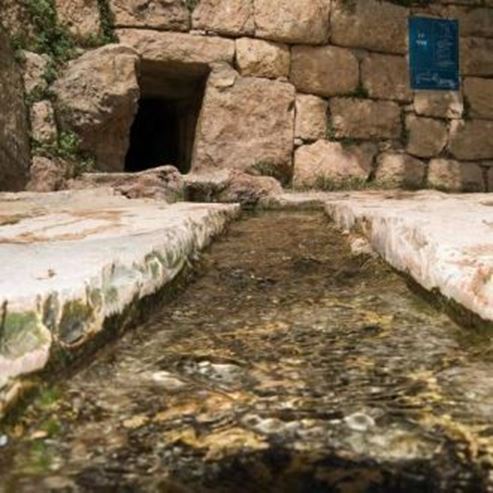Tzuba
Hiking
Route
Ein Tzuba -a charming little spring in the heart of a grassy area that is maintained by Kibbutz Tzuba.
This is a tunneled spring and the entrance is through the tunnel, it is particularly large and is unique in that it splits at the end, as well as a channel that leads the water from the origin to a rock-hewn pool that was used to store and regulate the water. Another nearby tunnel spring leads to a large indoor pool, and near to it are two more open-air pools, probably used in the past to produce clay material during the Second Temple period, and may have served as a ritual bath for the Jewish community that existed there.
Tel Tzuba -Tzuba is mentioned in the Bible as the place of origin of one of the heroes of David, Yigal Ben Natan. Most of the remains on the hill today are from the Crusader period, where the fortress of Belmont, meaning the beautiful mountain, was built. The fortress was one of a series of fortresses built along the road from Jaffa to Jerusalem, at relatively high points, not far from each other in order to preserve the main road. Arab village of Zuba was there until 1948.
The Cave of John the Baptist -John the Baptist of the generation of Jesus and a relative who lived and worked in the first century AD.
According to one tradition, he was born in Ein Karem, near Jerusalem, and was isolated in the desert for long periods of time.
It was John who identified Jesus' abilities, immersed him in the waters of the Jordan and proclaimed him Messiah, a Greek Christ.
According to tradition, John was captured by Herod Antipas and executed.
The cave was exposed by archaeologists who identify the cave as the place where John the Baptist isolated himself, as was inscribed in the New Testament.
The cave is decorated with Byzantine pictures, depicting the figure of John the Baptist and his life some 300 years later.
Kibbutz Palmach Tzuba -was founded on the 15th of Tishrei, 19/10/1948, and belongs to the United Kibbutz Movement. The kibbutz was founded by seventy-five Palmach veterans who fought in the area.
The name of the biblical settlement Tzuba was also named after the Arab village of Zuba.
At the time of the founding of the kibbutz, IDF forces were still fighting in the Jerusalem corridors, and therefore received its name, "Palmach Tzuba".
How to get there?
For those coming from the center on Route 1 to Jerusalem (east) at the Harel interchange, turn right onto road 3965 and continue straight to the big square (Har Eitan Junction).
Turn right onto road 395 and continue until you reach Kibbutz Tzuba.
Turn right and drive until you reach the Kibbutz parking lot.
Another possibility of arrival - from Highway 1, Tel Aviv - Jerusalem, turn at Sha'ar Hagai interchange to Route 38 in the direction of Beit Shemesh. After about 5 kilometers, at the Eshta'ol junction, turn left, according to the sign "Ksalon, Ramat Raziel, Tzuba, to Route 395.
After the turn, on the right side stands a triangular sign "Caution Deer" continue to follow the signs to Kibbutz Tzuba.
Enter Kibbutz Tzuba. Go straight at the circle, and on the right is the guest houses of the kibbutz. After about 400 meters you will arrive at the factory parking lot. We pass the factory on the right, to a small road with a green sign: "Ein Tzuba" (see pictures).
Continue on the winding road about a kilometer, to your left, fruit orchards will follow until you turn right to the parking lot.
Here you leave the vehicle and go down the path marked green about 300 meters until it forks, turn right and go about 50 meters to the sign to the spring. Entrance will be locked, which is why it is necessary to coordinate an opening with Kibbutz Tzuba.
What more?
At the entrance to Ein Tzuba, the Cave of John the Baptist can be accessed for a fee, and by prior appointment and local guides by phone - 02-5347000.
admission charge: Co-ordinate with Kibbutz Tzuba on phone
- Type
- Hiking
- Region
- Jerusalem Area
- Near to
- Jerusalem
- Length
- About 2 KM
- Duration
- About 2 hours
- Recommended season
- Spring, Summer, Autumn, Winter
- Difficulty level
- Easy
- Starting point
- Kibbutz Tzuba parking lot (map)
- Ending point
- Near Yochanan cave parking lot (map)
- Special equipment
- Walking shoes, Flashlights, Hat, Water, Sunscreen, Changeable clothes
- Parking
- Free Parking
- Drinkable water
- Drinkable water
- Bathing water
- Bathing water
- Suitable for children
- Suitable for children
- Picnic suitable
- Picnic suitable
- Phone
- +972-2-5347000
Similar trails







Nearby attractions







Nearby restaurants







